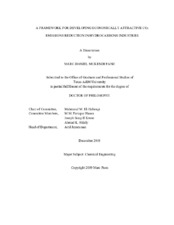| dc.contributor.advisor | El-Halwagi, Mahmoud M. | |
| dc.creator | Panu, Marc-Daniel Mukendi | |
| dc.date.accessioned | 2020-09-11T14:02:01Z | |
| dc.date.available | 2021-12-01T08:45:29Z | |
| dc.date.created | 2019-12 | |
| dc.date.issued | 2019-12-06 | |
| dc.date.submitted | December 2019 | |
| dc.identifier.uri | https://hdl.handle.net/1969.1/189148 | |
| dc.description.abstract | As concerns about climate change continue to intensify, one way to motivate companies to take meaningful climate action agnostic to political intervention is identifying economically attractive strategies to mitigate COv2 emissions. The idea of recycling and reusing waste resources is very established; however, there still exist numerous new opportunities to repurpose waste in the industrial sector. The objective of this work is to explore opportunities within the hydrocarbons processing industry to utilize excess resources to reduce COv2 emissions while improving overall economics. There are two key components in this work: the design of a Carbon-Hydrogen-Oxygen-SYmbiosis Network (CHOSYN) with COv2 emissions constraints, and the monetization of excess renewable power via the integration of power-to-gas (PtG) and the natural gas infrastructure. First, a bi-objective optimization based approach is proposed to understand the tradeoffs between cost reduction and COv2 emissions reduction while integrating an eco-industrial park. This work found that the economic tradeoff between maximizing COv2 abatement and maximizing cost savings was small. Second, a framework for integrating excess power and the natural gas infrastructure via electrolysis (PtG) to produce hydrogen, oxygen and other hydrocarbons was presented. The key features of this work were understanding the tradeoffs between total capacity and capacity utilization, and the co-monetization of both hydrogen and oxygen. This work found that although the economic return on PtG projects was small, the economic performance did improve meaningfully with the co-monetization of hydrogen and oxygen. | en |
| dc.format.mimetype | application/pdf | |
| dc.language.iso | en | |
| dc.subject | Industrial symbiosis | en |
| dc.subject | Process integration | en |
| dc.subject | Synthesis | en |
| dc.subject | CO2 | en |
| dc.subject | Mass integration | en |
| dc.subject | Power-to-gas | en |
| dc.subject | hydrogen | en |
| dc.subject | oxygen | en |
| dc.subject | natural gas | en |
| dc.subject | eco-industrial park | en |
| dc.subject | CHOSYN | en |
| dc.title | A Framework for Developing Economically Attractive CO2 Emissions Reduction in Hydrocarbons Industries | en |
| dc.type | Thesis | en |
| thesis.degree.department | Chemical Engineering | en |
| thesis.degree.discipline | Chemical Engineering | en |
| thesis.degree.grantor | Texas A&M University | en |
| thesis.degree.name | Doctor of Philosophy | en |
| thesis.degree.level | Doctoral | en |
| dc.contributor.committeeMember | Hasan, M. M. Faruque | |
| dc.contributor.committeeMember | Kwon, Joseph S. | |
| dc.contributor.committeeMember | Hilaly, Ahmad K. | |
| dc.type.material | text | en |
| dc.date.updated | 2020-09-11T14:02:02Z | |
| local.embargo.terms | 2021-12-01 | |
| local.etdauthor.orcid | 0000-0002-3174-012X | |


